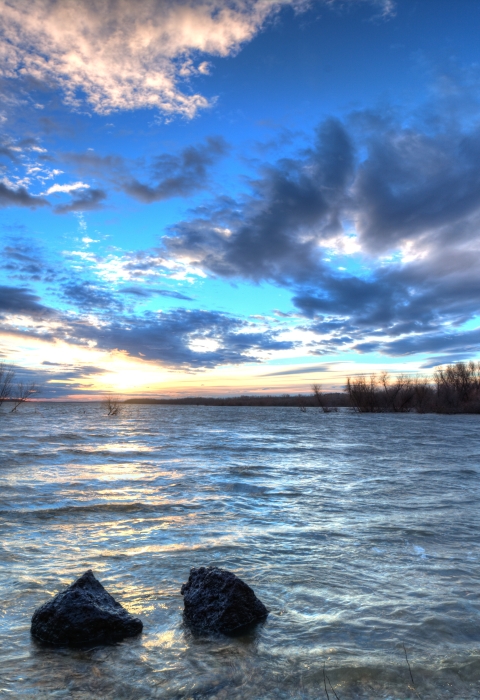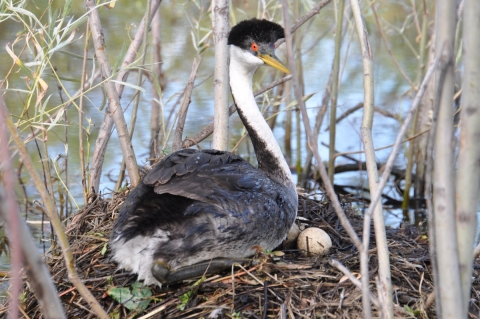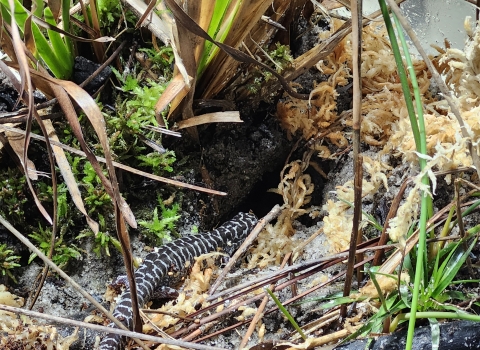A western grebe has red eyes.
They’re a bright, arresting red, firetruck red, the kind of red that makes you do a double-take and think, no, that can’t be right. Pitch black pupils sit bullseye-center. An imperial yellow beak pokes out just below. The rest of the bird is swathed in tuxedo-colored feathers, the front of its tall neck like a starchy white shirt and its back and body like a jacket with tails. Western grebes even have black tufty flattops, as if they came of age in the early 1990’s, couldn’t fit their spindly legs into parachute pants and so just settled for the haircut.
Deer Flat National Wildlife Refuge, a bird haven located in Nampa, Idaho, has the highest nesting population of these red-eyed stunners in the state. Western grebe, Clark’s grebe, and eared grebe can be found at the refuge, along with the occasional pied-billed grebe and horned grebe. The refuge is one of the oldest in the National Wildlife Refuge System and was established in 1909 as breeding grounds for migratory birds and other wildlife.
The refuge is also a critical resting and wintering area for birds migrating along the Pacific Flyway, including incredible congregations of ducks and geese. Visitors can see bald eagles, great horned owls, herons, double-crested cormorants, and a variety of songbirds — a colorful menagerie that graces the refuge’s skies year-round. The refuge protects a wide range of wildlife habitats: the open waters and wetland edges of Lake Lowell, the sagebrush sagebrush
The western United States’ sagebrush country encompasses over 175 million acres of public and private lands. The sagebrush landscape provides many benefits to our rural economies and communities, and it serves as crucial habitat for a diversity of wildlife, including the iconic greater sage-grouse and over 350 other species.
Learn more about sagebrush uplands around the lake and the grasslands and riparian riparian
Definition of riparian habitat or riparian areas.
Learn more about riparian forests on the Snake River islands. Mule deer, coyotes, yellow-bellied marmots, and many species of insects also call the refuge home.
Deer Flat provides important habitat for a wide variety of wildlife, especially grebes,” Refuge Manager Eddie Owens said. “We manage some premiere nesting and breeding ground. It’s awe-inspiring to look out and see these birds out here. We all feel a sense of responsibility to provide a home for them.”
Deer Flat National Wildlife Refuge has two units: Lake Lowell and the Snake River Islands. The Lake Lowell Unit encompasses more than 10,500 acres, including the almost 9,000-acre Lake Lowell and surrounding lands. The Snake River Islands Unit contains more than 1000 acres on 104 islands. The islands within the refuge are distributed along 113 river miles that cross the Idaho-Oregon border.
Grebes tend to congregate around Lake Lowell, where the pink-flowered smartweed provides cozy nesting habitat. Originally planted in 1938, smartweed provides an abundance of nesting materials and foraging habitat. Western and Clark’s grebes spend almost all their time in water, feeding, dancing, resting, and weaving nests.
In recent years, the numbers of nesting grebes have dropped. In 2021, the U.S. Fish and Wildlife Service (Service) listed western Grebe and Clark’s Grebe as Species of Conservation Concern. The North American Breeding Bird Survey has registered a 75% decline in their populations since 1966. While researchers have posited theories behind these species’ decline, no single reason has been identified as the main culprit.
The Service recently formed a working group to foster partnerships and gather data about this understudied bird to head off further declines and help restore populations.
“The grebe is an understudied species,” Owens said. “We’re partnering with Idaho Fish and Game to do more monitoring, including coordinating drone flights to do surveys, nest counts, and track nest success.”
Idaho Fish and Game is using State Wildlife Grant funds, in part, to tally adult western grebes prior to nesting and adult and chicks post-nesting. The State Wildlife Grant program is administered by the Service’s Wildlife and Sport Fish Restoration Program and is designed to benefit at-risk species just like the western grebe. Because the grant program allows for long-term monitoring, the state can repeat the study at intervals over many years.
According to the 2022 U.S. Census, Nampa is one of the fastest growing cities in the country. As urban areas increase, the refuge serves as a connection to nature for wildlife, residents, and visitors. There is a myriad of educational, wildlife watching, and recreational opportunities. While the grebe may stand out for its red eyes and innate sense of style, the colorful refuge provides occasions for everyone to celebrate. Bring your binoculars, hiking shoes, and fishing pole — and even your tuxedo if you want to jam like the grebes.






